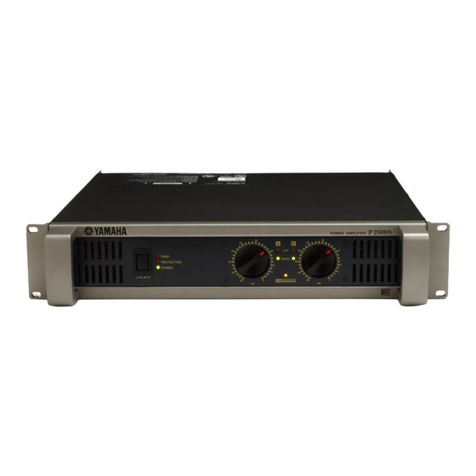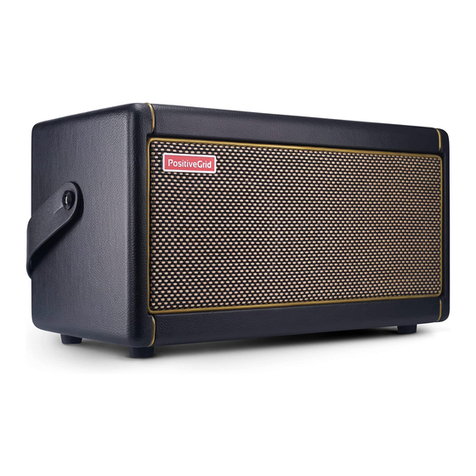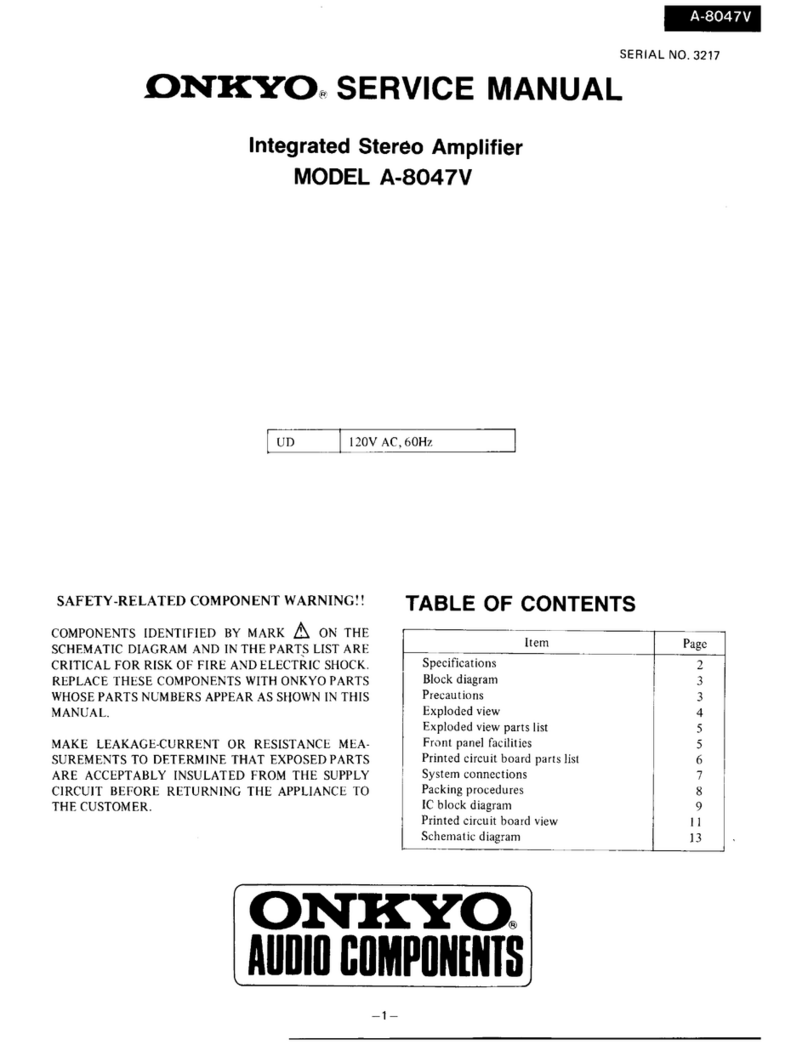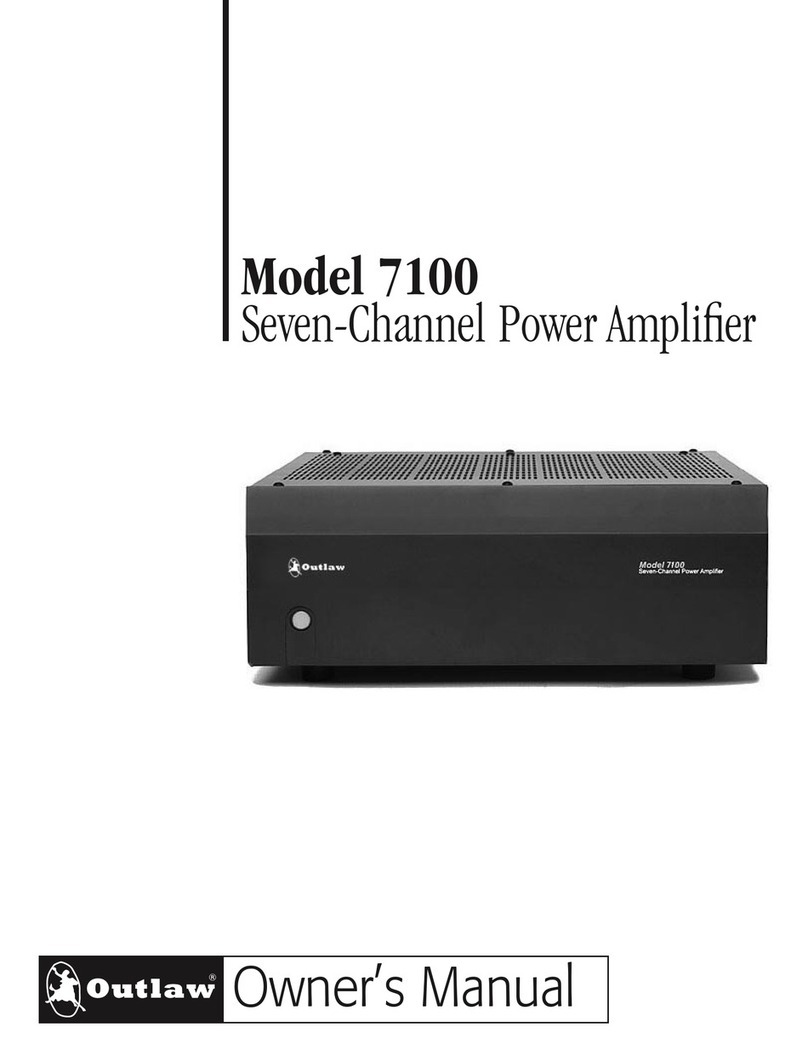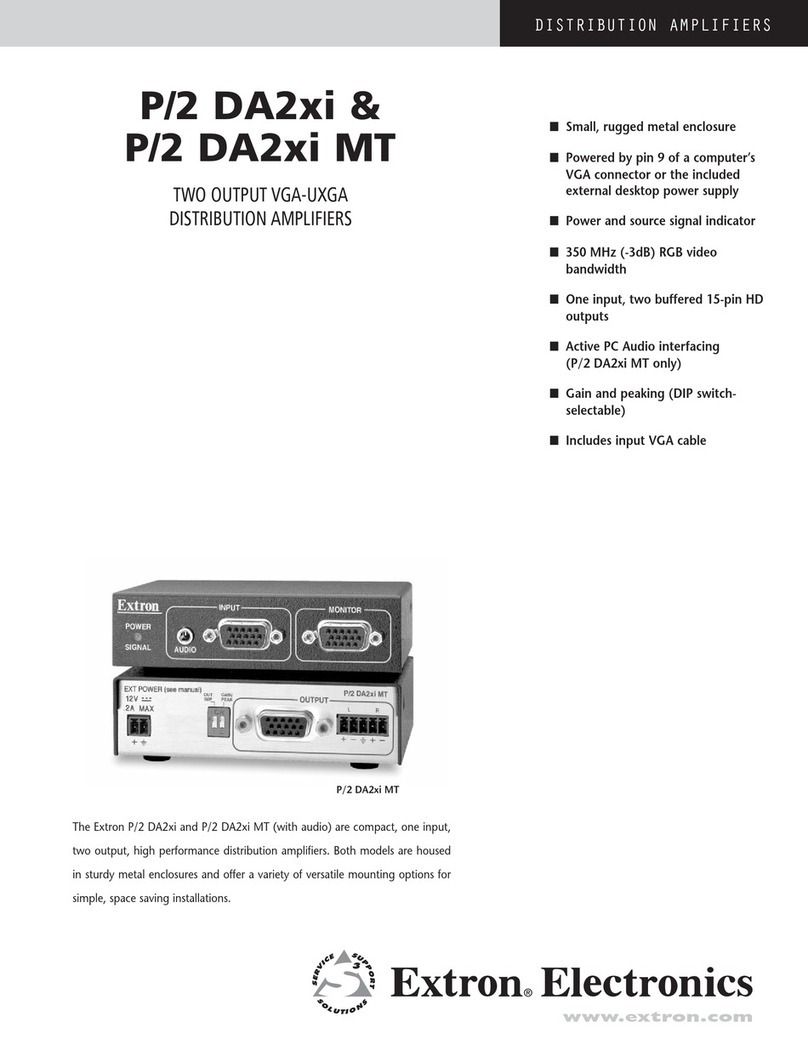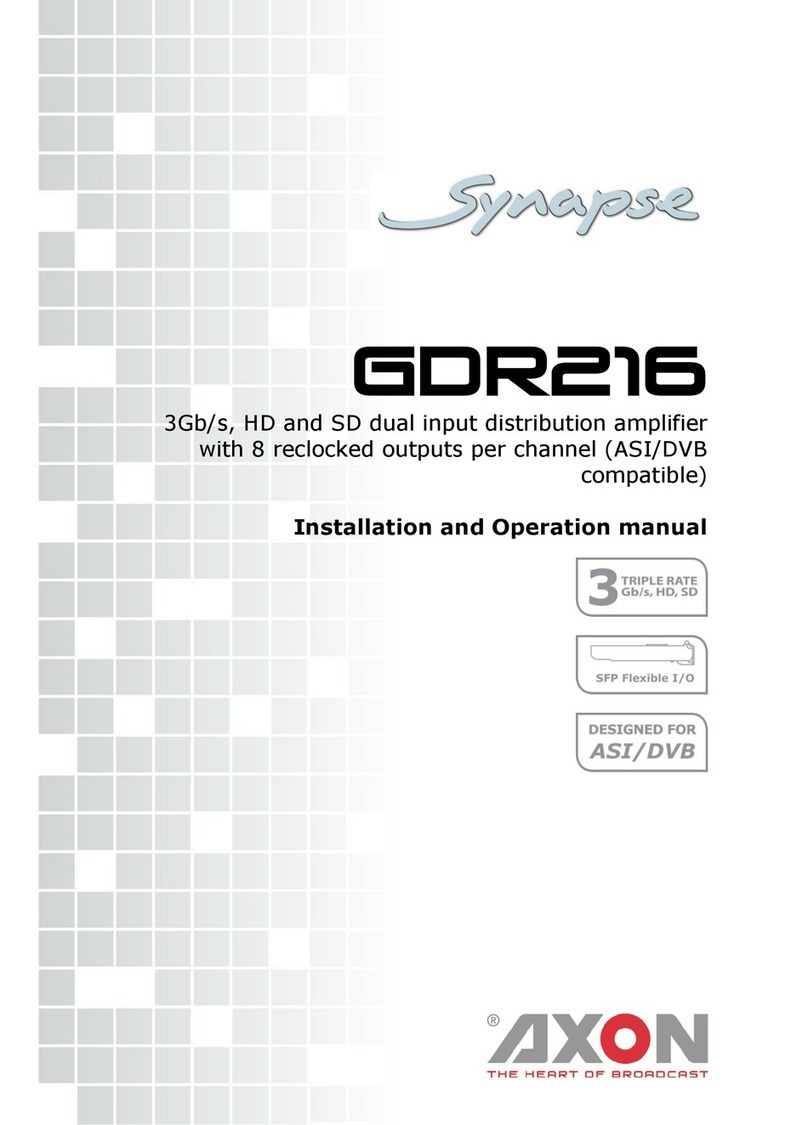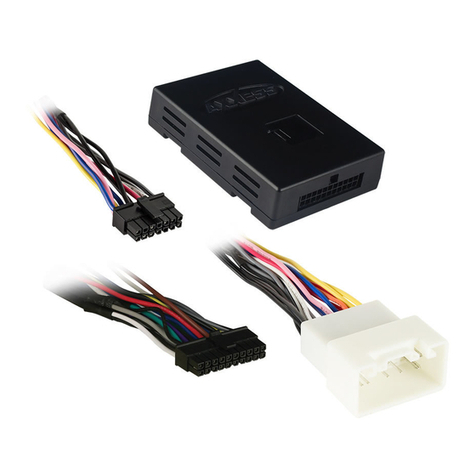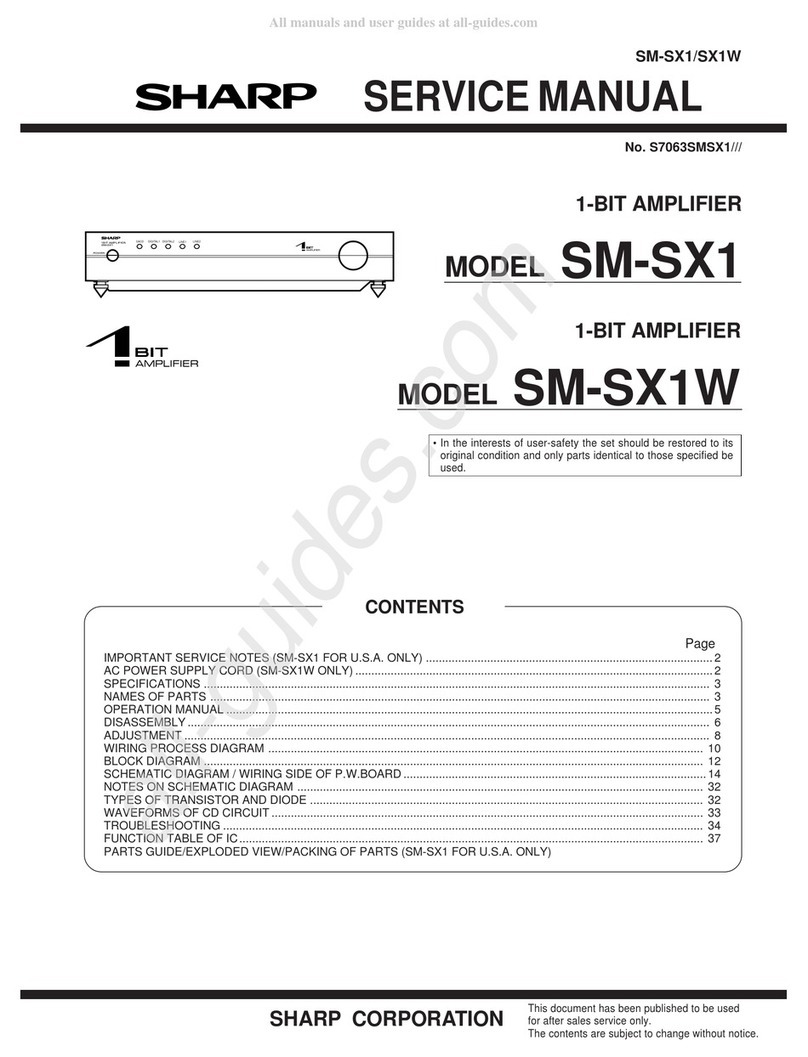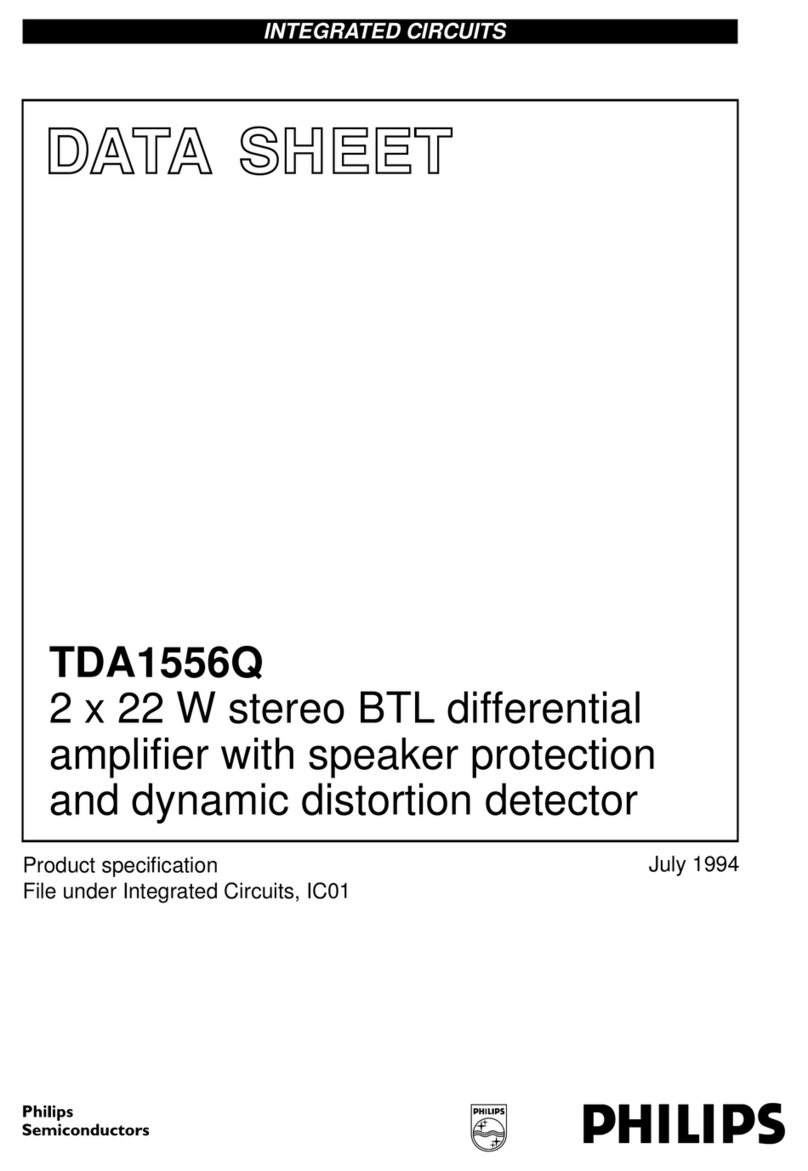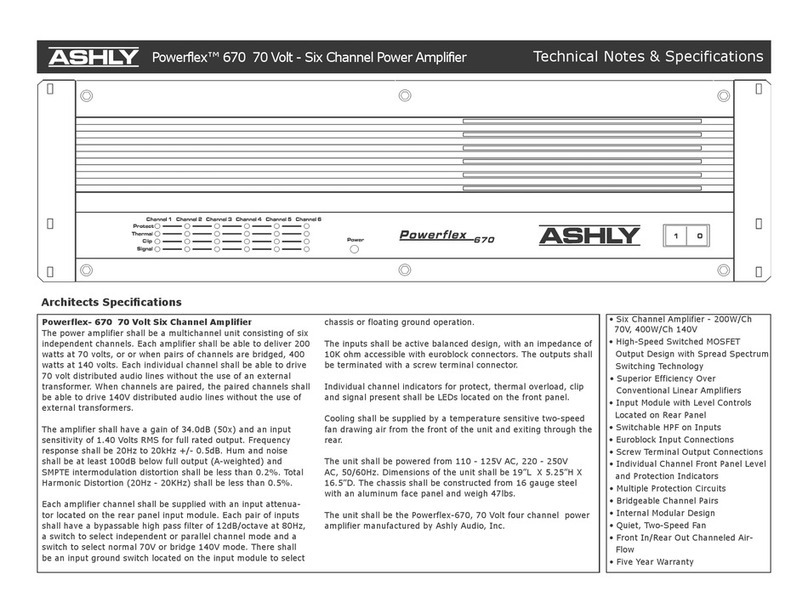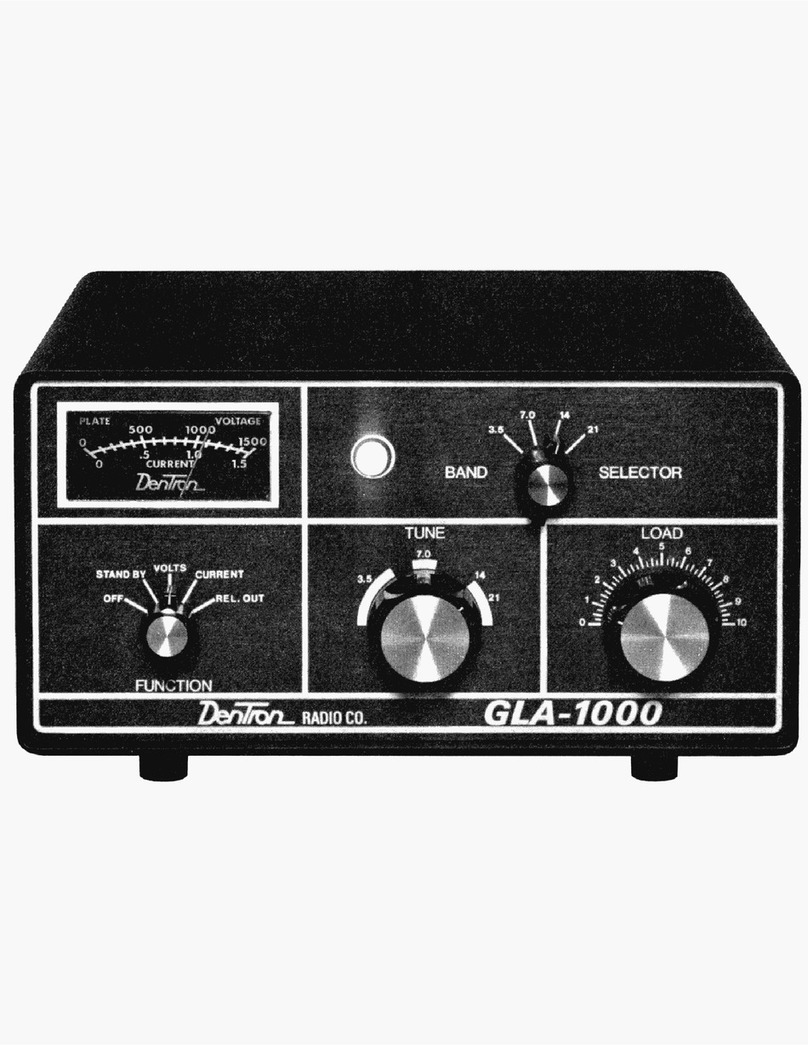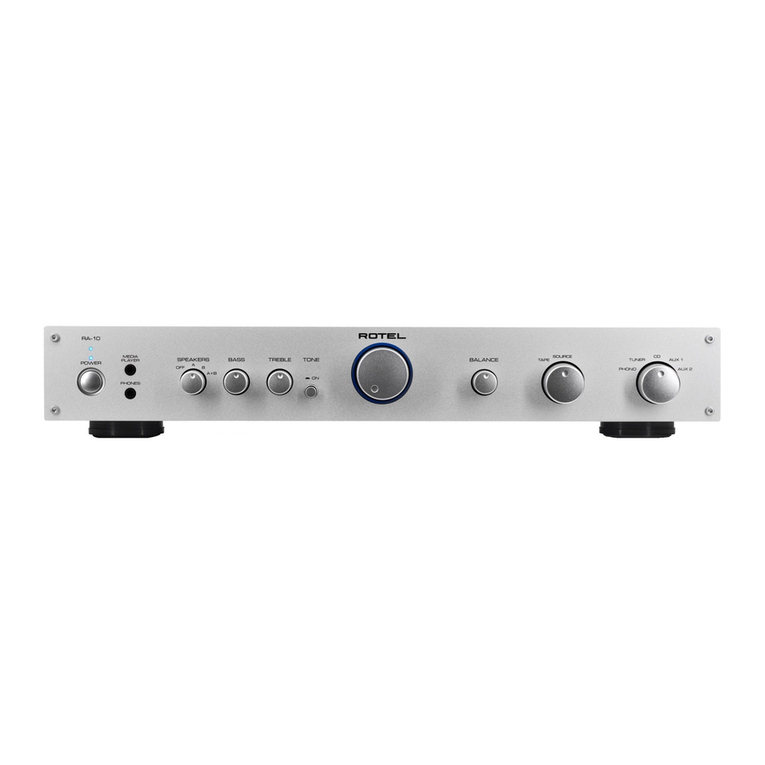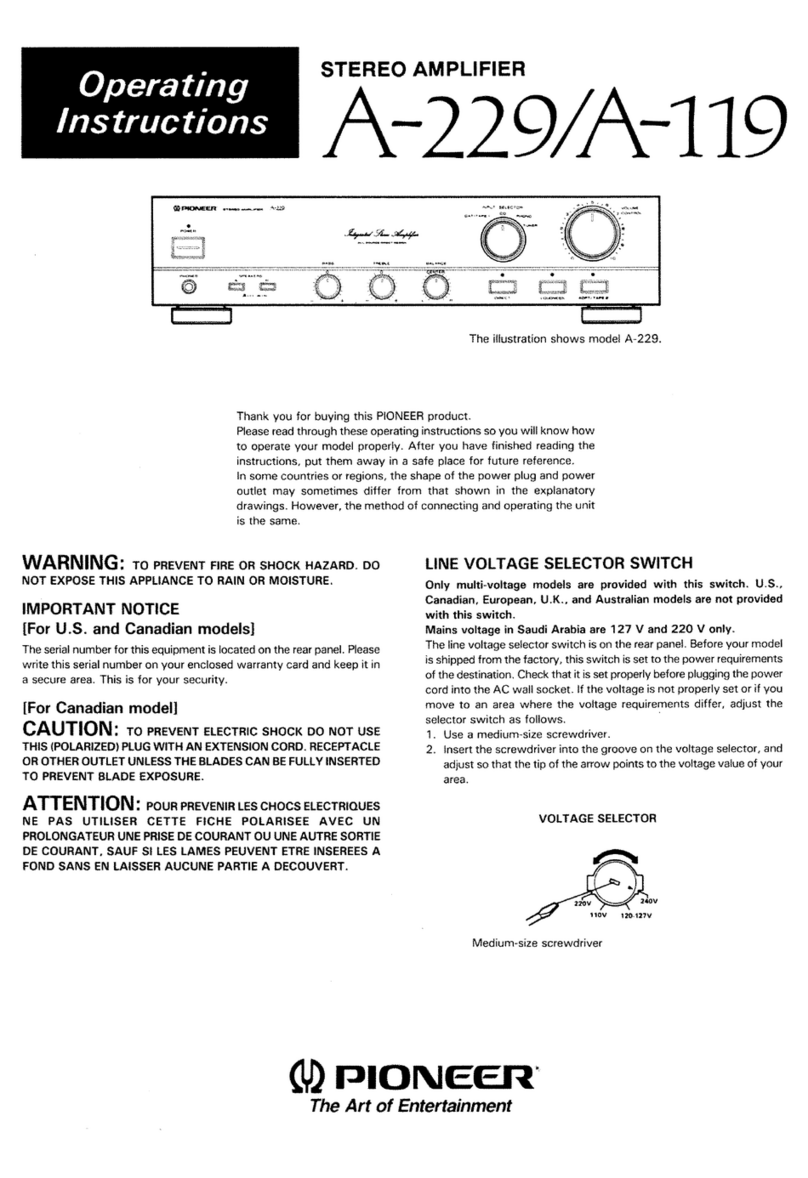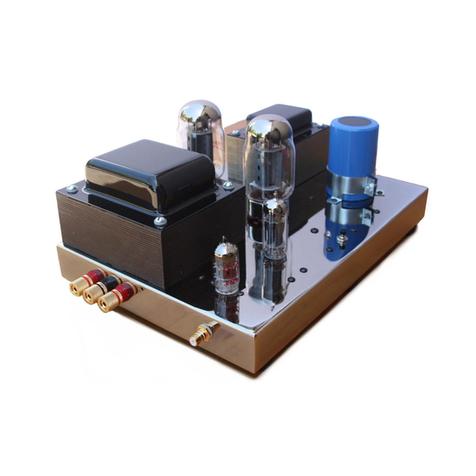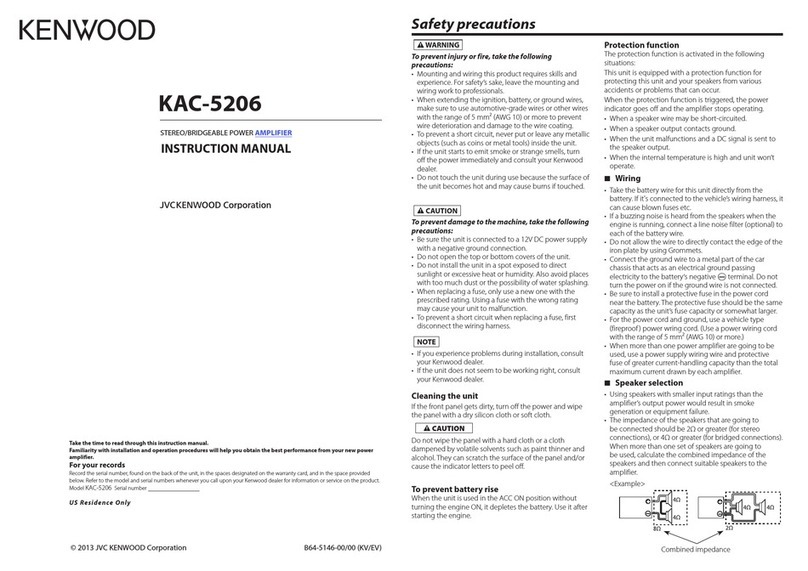Bouyer GE 3267 User manual

MODULE MULTI-SOURCES
TUNER AM/FM
LECTEUR CD MP3
PRÉAMPLIFICATEUR
TUNER AM/FM
CD MP3 PLAYER
PREAMPLIFIER
MULTI-SOURCE MODULE
425 mm
345
92 mm
Le GE 3267 intégre trois sources dans un
même coffret : un tuner AM/FM, un lecteur
CD MP3 et un préamplificateur à une voie
(Mic/Aux) avec détection de modulation.
Chaque source dispose d’un réglage de vol-
ume et de sa propre sortie symétrique avec
télécommande. La sortie du préamplifica-
teur est symétrique flottante par transforma-
teur.
Une autre sortie permet de choisir la source
désirée avec un sélecteur en face avant.
Le GE 3267, au format 2U 19” (Fig. I), peut
être intégré dans une baie en installant les
poignées AZ 7, en option (Fig. II).
The GE 3267 includes three sources in the
same box : a tuner AM/FM, a CD MP3
player and a one-way preamplifier with one
way (Mic/Aux) with detection of the modu-
lation.
Each source has a setting for the volume
and its own output balanced to the remote
control. The output of the preamplifier is
balanced through a transformer.
An other output enables to select the desi-
red source using a selector on the front.
The GE 3267 with a format 2U 19” (Fig. I)
may be included in a rack by installing the
AZ 7 handles as an option (Fig. II)
• Preamplifier input........................ Mic or Aux
Configuration by pushbutton.
Mic : Electrodynamical or electret
- DIN and XLR balanced
Sensitivity ......................................- 52 dBu
Impedance ...................................... 2 kohm
Phantom power supply .................... 12V
Remote control input ........4 and 2 DIN
Detecting the modulation and setting
sensitivity.
- Jack 6.35 unbalanced
Input on the front and input at the
back.
Sensitivity ........................................-35 dBu
Aux :
- DIN and XLR balanced
Sensitivity ........................................ -10 dBu
Impedance .............................. 100 kohm
Remote control input 4 and 2 DIN
Detecting the modulation and setting
sensitivity.
- Jack 6.35 unbalanced
Input on the front and input at the
back.
Sensitivity ...................................... +10 dBu
• Tuner (aerials supplied) :
AM : 531kHz to 1602 kHz
FM : 87.5 MHz to 107 MHz
• CD player :
Compatible CD-RW and MP3
• DIN outputs
- CD, Tuner, Select : balanced electronic
- Balanced preamplifier via a transformer
- Remote control: pins 4 and 2 DIN
• Mains supply (wire supplied) :
230V - 50/60 Hz with earth
• Consumption .......................................... 25 VA
• Temperature in use.................... -5° to +55°C
• Storage temperature .......... -10° to +70°C
• Dimensions (Fig.I) .... 425 x345 x92 mm
• Weight ........................................................ 5,4 kg
• Option ............................ Handles AZ 7 (Fig.II)
Ce document n'est pas contractuel; toute modification pouvant intervenir sans préavis / This document is not legally binding, we reserve the right to modify descriptions and specifications without notice.
Code 596 309 - 07/05
I - DESCRIPTION I - DESCRIPTION
II - CARACTERISTIQUES TECHNIQUES II - TECHNICAL SPECIFICATIONS
480 avenue de Paris • 82000 MONTAUBAN • FRANCE
Tél : 33 (0)8 92 70 20 82* (*0,34 €la minute TTC) • Fax : 33 (0)5 63 03 08 26 • http://www.bouyer.com
G
GE
E
3
32
26
67
7
• Entrée préamplificateur.......... Mic ou Aux
Configuration par bouton poussoir
Micro : électrodynamique ou électret
- Symétrique DIN et XLR
Sensibilité ...................................... - 52 dBu
Impédance ...................................... 2 kohm
Alimentation fantôme........................ 12V
Entrée télécommande ..........4 et 2 DIN
Détection de modulation avec réglage
de sensibilité.
- Asymétrique Jack 6.35
Une entrée en face avant et une en
face arrière.
Sensibilité ........................................ -35 dBu
Aux :
- Symétrique DIN et XLR
Sensibilité ........................................ -10 dBu
Impédance .............................. 100 kohm
Entrée télécommande 4 et 2 DIN
Détection de modulation avec réglage
de sensibilité.
- Asymétrique Jack 6.35
Une entrée en face avant et une en
face arrière.
Sensibilité ...................................... +10 dBu
• Tuner (Antennes fournies) :
AM : 531kHz à 1602 kHz
FM : 87,5 MHz à 107 MHz
• Lecteur CD :
Compatible CD-RW et MP3
• Sorties DIN
- Tuner, CD, Select : sym. électroniques
- Préampli : sym. par transformateur
- Télécommande : broches 4 et 2 DIN
• Alimentation secteur (Câble fourni) :
230V - 50/60 Hz avec terre
• Consommation ...................................... 25 VA
• Température d’utilisation ...... -5° à +55°C
• Température de stockage .. -10° à +70°C
• Dimensions (Fig.I) .... 425 x345 x92 mm
• Poids ............................................................ 5,4 kg
• Option.......................... Poignées AZ 7 (Fig.II)
Fig. I
Fig. II
AZ 7 - Jeu de poignées 2U
AZ 7 - Set of handles 2U

2GE 3267
III - PRESENTATION III - PRESENTATION
A l'avant (Fig. III)
1Interrupteur de mise sous tension.
2Prise jack entrée préamplificateur.
3Atténuation musique en sortie préamplificateur.
4Réglage du volume préampli.
5Réglage du volume Tuner.
6Réglage du volume lecteur CD.
6Voyants des sources sélectionnées.
Bouton de sélection des sources.
7Réglage du volume de la source sélectionnée.
9Lecteur CD MP3 (détail Fig. VI).
Tuner AM/FM (détail Fig. V).
A l'arrière (Fig. IV)
Prise de connexion antenne FM.
Bornier de connexion antenne AM.
Prise jack entrée préamplificateur.
Atténuateur sur détection de modulation
Entrée préampli sur DIN.
Bouton poussoir sélection Aux ou Mic.
Entrée préampli sur XLR.
Sortie préampli sur DIN.
Sortie Tuner sur DIN.
Sortie lecteur CD sur DIN.
Sortie Sélection sur DIN.
Prise secteur 230V avec terre et fusible.
TUNER - AM : 531kHz à 1602 kHz - FM : 87,5 MHz à 107 MHz (Fig. V)
Afficheur fréquence et numéro de station.
Touche “POWER” - La modulation du tuner est normalement
coupée dès qu’un CD est en lecture. Cette touche permet aussi
de couper manuellement le tuner.
Touche “BAND” - Choix de la bande AM ou FM.
Touche “MEMORY” - Mémorisation des stations.
Touche “SLEEP” - En appuyant cette touche, le tuner est pro-
grammé pour fonctionner 90 mn, puis s’arrête. A chaque impul-
sion supplémentaire le temps diminue de 10 mn.
Touche “DOWN” - Recherche des stations - fréquences décrois-
santes. Touche maintenue = défilement rapide.
Touche “UP” - Recherche des stations - fréquences croissantes.
Touche maintenue = défilement rapide.
Touches “1-2-3-4-5” - Mémorisation des stations.
Touche “+5” - Permet de sélectionner un numéro de station
mémorisée supérieur à 5 et jusqu’à 10, ex : 6 = (+5) + (1).
Touche “ME-UP” - Permet de sélectionner le numéro de station
mémorisé suivant.
• Recherche des stations
Utiliser les touches et pour rechercher la station désirée.
Maintenir l’une de ces touches pendant 2 secondes pour lancer la
recherche automatique.
•Mémorisation d’une station
Rechercher la station avec les touches et .
Appuyer sur la touche “MEMORY” .
Composer le numéro de1 à10 avec les touches et .
Appuyer à nouveau sur la touche “MEMORY” .
32
32
33
33
30
30
34 35
TUNER - AM : 531kHz to 1602 kHz - FM : 87.5 MHz to 107 MHz(Fig. V)
Notification of frequency and station number.
“POWER” key – Modulation of the tuner is normally cut off as
soon as a CD is being read. This key also allows cutting off
the tuner manually.
“BAND” key. To select the band AM or FM.
“MEMORY” key to memorise stations.
“SLEEP” key - By pressing on this key, the tuner is programmed to
operate 90 minutes then stop. Each time this is pressed again, time
is reduced by 10 minutes.
“DOWN” key - Search for stations - frequencies decreasing
With the key pressed on, fast running.
“UP” key - Search for stations - frequencies increasing.
With the key pressed on, fast running
Keys
“1-2-3-4-5” - Memorising the stations.
“+5” key - For selecting a memorized station No. higher than
5 and up to 10, e.g., 6 = (+5) + (1).
“ME-UP” key - For selecting the next memorized station No.
•
Station search
Use and keys to find the required station.
Push on the key during 2 seconds to start the automatic search.
•
Station memory
Search for the station, using keys
and .
Press the “MEMORY” key
.
Enter the number from 1 to 10, using keys and
.
Press the “MEMORY” key again.
27
28
29
30
31
32
32
32
33
33
33
34
35
36
30
30 34 35
1
2
3
4
5
6
7
8
9
10
11
12
13
14
15
16
17
18
19
20
21
22
23
27
28
29
30
31
32
33
34
35
36
Lecteur CD - Compatible CD-RW et MP3 (Fig. VI)
MP3 - Bit rate = 32 kbps ∼ 320 kbps - Sampling : 32 kHz - 44,1 kHz -
48 kHz - CD gravé selon la norme ISO 9660.
Tiroir du CD.
Afficheur : Nombre et numéro de plage (CD audio) - Nombre et
numéro de répertoire et de fichier MP3.
Touches de recherche des plages ou fichiers précédents ou suivants.
Touche d’arrêt lecture.
Touche lecture/pause.
Touche d’ouverture et fermeture du tiroir CD.
Touche sélection du chiffre des centaines pour les fichiers MP3.
Touche sélection du chiffre des dizaines pour les fichiers MP3.
Touche sélection du chiffre des unités pour les fichiers MP3.
Touche répétition de lecture d’une plage ou de tout le CD (CD
audio) et d’un fichier, d’un répertoire ou de tout le CD (CD MP3).
Touche de sélection du répertoire précédant ou suivant (CD MP3).
37
38
39
40
41
42
43
44
45
46
47
In the front (Fig. III)
1On/Off switch.
2Jack input to preamplifier.
3Reducing of music preamplifier output.
4Setting volume on preamplifier.
5Tuner volume setting.
6CD player setting of volume.
6Lights for selected sources.
Lights for selected sources.
7Setting the volume of the selected source.
9CD MP3 Player (see detail on Fig. VI).
AM/FM tuner (see detail on Fig. V)).
1
2
3
4
5
6
7
8
9
10
11
To the rear (Fig. IV)
Connecting socket for FM aerial.
Terminal strip for connecting AM aerial.
Jack input to preamplifier.
Attenuator switch according to detection of modulation.
Preamplifier input on DIN.
Selection pushbutton for Aux or Mic.
Preamplifier input on XLR.
Preamplifier output on DIN.
Preamplifier output on DIN.
CD Player outlput on DIN.
Selection output on DIN.
Mains socket 230V with earth and fuse.
12
13
14
15
16
17
18
19
20
21
22
23
CD player - CD-RW & MP3 compatible
(Fig. VI)
MP3 - Bit rate = 32 kbps ∼ 320 kbps - Sampling : 32 kHz - 44,1 kHz -
48 kHz -
CD burned in accordance with ISO 9660.
CD tray.
Display: Total quantity of tracks and track No. on Audio CD -
Total quantity, folder No. and file No. of MP3 files.
Keys for searching previous or next tracks or files.
Stop key.
Play/Pause key.
CD tray open/close key.
Key for selecting the hundreds digit of an MP3 file No.
Key for selecting the tens digit of an MP3 file No.
Key for selecting the units digit of an MP3 file No.
Key for repeating play of a track or entire CD (of an Audio CD),
and a file, folder, or entire CD (of a MP3 CD).
Key for selecting previous or next folder (on an MP3 CD).
37
38
39
40
41
42
43
44
45
46
47

GE 3267 3
12 13
AM
14 15 16 17 18 19 20 21 22 23
ATTENTION :
débrancher le
secteur avant
d'ouvrir
CAUTION :
disconnect
from supply
before opening
MONTAUBAN - FRANCE
230V
50/60Hz
FUS.
T160mA
FM
Detect
Level Aux
Mic
Mic/Aux Tuner CD Select
Outputs
Input Mic/Aux
Output
Télécom.
Remote
31
524
Télécom.
Remote
31
5243
1
2
Fig. IV
2
79
I
0
DIGITAL AM/FM TUNER
GE 3267
Mic/Aux
Mic/Aux Tuner CD
Select
Mic/Aux
Tuner CD
CD>TUNER
1
344 5 6 8
11 10
Music
Fig. III
34
27 28 29 30 31 32 33
35 36
POWER
BAND MEMORY SLEEP DOWN UP
1 2 3 4 5 +5 ME-UP
Fig. V
/
DOWN/REW UP/FF STOP PLAY/PAUSE OP/CL
HUNDRED TEN UNIT REPEAT -FOLDER SKIP-
REMOTE
EC-330R
discdisc
COMPACT
DIGITAL AUDIO
37
43 44 45 46 47
39 40 41 42
38
Fig. VI
MAINTENANCE MAINTENANCE
En cas de panne :
•
Vérifier l’état du fusible et le remplacer si besoin par un fusible
de mêmes caractéristiques tel qu’indiqué sur l’appareil.
•
Attendre que l’appareil refroidisse pour s’assurer que la panne
n’est pas due à la protection thermique.
•
Sinon retourner l’appareil à l’usine, ou faire appel à un dépan-
neur professionnel.
In case of failure :
•Check the status of the fuse and replace them if needed by
fuse with the same characteristics as those indicated on the
product.
•Wait until the product has cooled off, to be sure that the failu-
re is not caused by the thermal relay.
•Otherwise the product has to be sent back to the factory or
repaired by a recognised dealer.
!!

GE 3267
AMPLIFICATEUR
AMPLIFIER
- Musique d'ambiance
- Background music
GZ 33 ou/or GZ47
4GE 3267
Ex 1
- Musique d'ambiance
- Appel par microphone prioritaire
ou mélangé à la musique
- Background music
- Priority microphone call or call
mixed with music
GE 3267
Déport
Remote
AMPLIFICATEUR
AMPLIFIER
Ex 2
- Musique d'ambiance
- Appel ou Animation par microphone sans fil
prioritaire ou mélangé à la musique
- Background music
- Call or animation through a wireless
microphone priority or mixed with music
GE 3267
GZ 2802
GM 2800
GZ 44
AMPLIFICATEUR
AMPLIFIER
Déport
Remote
Ex 3
- Microphone UHF et musique prioritaires
sur la source auxiliaire
- Wireless microphone and priority music
on the auxiliary source
AS 3066
ou/or AS 3126
ou/or AS 3246
GE 3267
GZ 2802
Source auxiliaire
Auxiliary source
GM 2800
GZ 44
Signal +
Télécommande
Remote control
Ex 4
Musique +
Appel micro
Music +
Microphone call
AMPLIFICATEUR
AMPLIFIER
GE 3267
Musique tuner
Tuner music
Musique CD
CD music
Sélection
Selection
AMPLIFICATEUR
AMPLIFIER
AMPLIFICATEUR
AMPLIFIER
AMPLIFICATEUR
AMPLIFIER
Ex 5
- Musique d'ambiance
- Microphone d'appel prioritaire sur musique
- Message enregistré prioritaire sur
microphone et musique
- Backgound music
- Priority microphone call on music
- Priority message recorded on microphone
and music
AMPLIFICATEUR
AMPLIFIER
GE 3267
GD 4128
Commande message
Message control
Déport
Remote
Ex 6
AMPLIFICATEUR
AMPLIFIER
GE 3267
Lecteur MP3
MP3 player
Déport
Remote
Ex 7
Animation déportée
Remote animation
Animation déportée
Remote animation
Animation déportée
Remote animation

GE 3267 5
• Branchement secteur (Fig. IV)
L’appareil est livré pour un fonctionnement en 230V avec terre.
•Branchement des antennes ou (Fig. IV)
Connecter l’antenne FM (en T) en 12 et la fixer verticalement
contre une paroi non métallique.
Connecter l’antenne AM (cadre) en 13 et la fixer verticalement.
•
Branchement de l’entrée Mic/Aux - Jack DIN XLR
Cette entrée peut recevoir un microphone électrodynamique et
électret (bouton 17 relâché) ou une sortie auxiliaire -10dB (bou-
ton 17 appuyé)
Le réglage de volume s’effectue en face avant, bouton 4 .
Cette entrée est dotée d’une détection de modulation dont le
niveau est réglable en face arrière 15 et d’une entrée télécom-
mande sur les broches 4 et 2 de la prise DIN 16 uniquement.
•
Branchement de la sortie Mic/Aux - DIN
(Fig. IV)
Cette sortie préamplificateur symétrique est équipée d’un trans-
formateur et autorise une liaison longue distance et de bonne
qualité vers un amplificateur de puissance.
Sur le broche 4 de la prise DIN on dispose de la télécommande
reçue en entrée Mic/Aux et de la télécommande générée par la
détection de modulation.
•
Branchement de la sortie Tuner - DIN
(Fig. IV)
Cette sortie symétrique électronique est à connecter à l’entrée d’un
amplificateur de puissance. La télécommande est toujours active.
•
Branchement de la sortie CD - DIN
(Fig. IV)
Cette sortie symétrique électronique est à connecter à l’entrée
d’un amplificateur de puissance. La télécommande est activée
par détection de modulation du signal CD.
•
Branchement de la sortie Select – DIN
(Fig. IV)
Cette sortie symétrique électronique est à connecter à l’entrée
d’un amplificateur de puissance. La télécommande est celle de
la source sélectionnée.
•
Cordons de liaison
Sortie Cordon Entrée
GZ 33 AS 3066 - AS 3126 - AS 3246
GE 3267 GZ 33 ou GZ 47 PR1106 - PA1050 - PA1100 - PA1180
GZ 47 AR 1050 - AR 1100 - AR 1180 -
AR 1402 - AR 2242
IV - INSTALLATION IV - INSTALLATION
CAUTION !
The unit is neither water - nor splash proof.
Before any manipulation, disconnect the mains cable.
After manipulation, put back the cover and check that
the “earth” wire (yellow + green) is connected properly.
!
ATTENTION !
L’appareil ne doit pas être exposé aux chutes d’eau et
aux éclaboussures.
Avant toute intervention, déconnecter le câble secteur.
Après l’intervention, refermer l’appareil et vérifier que
le fil de terre (jaune et vert) soit bien connecté.
!
23
17
15
17
19
20
21
22
• Mains connection (Fig. IV)
This appliance is supplied for operation with a grounded 230V
mains supply.
• Antennas
Connect the T-shaped FM antenna to (Fig. IV) and fasten this
antenna vertically against a non-metal surface.
Connect the AM antenna frame to (Fig. IV).
•
Mic/Aux input connection (DIN) - Jack DIN XLR
This input may receive an electrodynamical microphone and elec-
tret (button released) or an auxiliary output -10dB (key 17 pres-
sed)
Setting the volume is made on the front with the key
This input has a modulation detection for which the setting is at the
back 15 and a remote controlled input for the pins 4 and 2 of the
sole DIN 16 socket.
•
Connecting the output Mic/Aux - DIN
(Fig. IV)
This balanced preamplifier output is fitted with a transformer
and allows a long distance link and with good quality to a boos-
ter amplifier.
On the pin 4 of the DIN socket, there is the remote control recei-
ved on the Mic/Aux input of the remote control generated by
the modulation detection.
•
Connecting the Tuner output - DIN
(Fig. IV)
This balanced electronic output should be connected to the
input of a booster amplifier. The remote control is still active.
•
Connecting the CD output - DIN
(Fig. IV)
This balanced electronic output should be connected to the
input of a booster amplifier. The remote control is actived by the
CD signal modulation detection .
•
Connecting the Select output – DIN
(Fig. IV)
This balanced electronic output is to be connected with the
input of a booster amplifier. The remote control is that of the
selected source.
•
Link cables
Output Cable Input
GZ 33 AS 3066 - AS 3126 - AS 3246
GE 3267 GZ 33 or GZ 47 PR1106 - PA1050 - PA1100 - PA1180
GZ 47 AR 1050 - AR 1100 - AR 1180 -
AR 1402 - AR 2242
23
17 17
19
12
12
13
13
12
13
14
44
16
16 16
18
La sortie Mic/Aux reçoit en mélange la modulation musique
CD/Tuner. Le réglage de volume de cette sortie s’effectue avec le
bouton .
Le niveau de la musique est ajustable avec l’atténuateur 3
(Fig.III). La musique est coupée par l’activation de la télécomman-
de de l’entrée Mic/Aux et/ou par la détection de modulation de
cette entrée.
Les deux sources, Tuner et CD, ont chacune leurs sorties et leurs
réglages de volume et peuvent donc être utilisées séparément.
Leur réglage de volume s’effectue avec les boutons 5 et 6 .
La sortie “SELECT” permet de sélectionner avec le bouton pous-
soir et les voyants l’une des sources suivantes :
- Mic/Aux avec ou sans musique selon la position du sélecteur
- Tuner
- CD
- CD/Tuner. Le tuner prend le relais en fin de lecture du CD.
Le réglage de volume de la source sélectionnée s’effectue avec le
bouton 9 .
3
5
78
9
3
6
V - UTILISATION V - USE
4
14 16 18
15
20
21
The output Mic/Aux receives a mixture of Music modulation
CD/Tuner. Setting the volume for this output is made with key
The level of music is adjustable using the attenuator switch
(Fig. III). Music is cut by activating the remote control in input
Mic/Aux and/or by detecting the input modulation.
Both inputs Tuner and CD have each their output and volume set-
ting and may be used separately. Their volume setting is made
using the keys and .
The “SELECT” output allows the selection with the pushbutton
and the lights , one of the following sources :
- Mic/Aux with or without music according to the selected posi-
tion of
- Tuner
- CD
- CD/Tuner. The tuner takes over after the CD is read.
Setting the volume of the selected source is made using the key
.
5
7
8
9
3
6
4
22
3

6GE 3267
Ex 1 -
Système simple de diffusion de musique d’ambiance
Connecter la sortie “Mic/Aux” à l’entrée de l’amplificateur de
puissance.
Avec le bouton de sélection 8 (Fig. III) il est possible de choisir
entre Tuner ou CD ou CD+Tuner, dans ce dernier cas à la fin de lec-
ture du CD l’appareil commute sur Tuner. Le volume est réglable
avec le bouton 9 quelle que soit la source.
Ex 2 -
Centrale de sonorisation compacte, déportée ou non de
l’amplificateur de puissance pour diffusion de musique
d’ambiance et appels par microphone
Connecter un microphone en 16 ou 18 . Relâcher le bouton pous-
soir 17 en position Mic. Connecter la sortie Mic/Aux 19 du
GE 3267 à l’entrée de l’amplificateur.
Régler le niveau des appels microphone avec le bouton 4 puis
ajuster le niveau de la musique avec le bouton atténuateur 3 . Le
volume 4 agit sur Mic et Musique.
Avec un microphone pourvu d’une télécommande la musique est
coupée à chaque appel.
Avec un microphone dépourvu d’une télécommande, régler le
niveau de détection de modulation 15 en face arrière, pour obtenir
la coupure de la musique au seuil souhaité.
Avec un microphone dépourvu de télécommande, et si le réglage
de détection est à zéro les appels sont diffusés en mélange avec la
musique.
Ex 3 -
Centrale de sonorisation compacte, déportée ou non de
l’amplificateur de puissance pour diffusion de musique
d’ambiance et appel ou animation avec microphone
UHF(800MHz) GM2800 et son récepteur GZ2802
Connecter un cordon GZ44 de la sortie XLR du canal utilisé sur le
GZ2802 à l’entrée 16 du GE 3267. Relâcher le bouton poussoir
17 en position Mic. Connecter la sortie MIC/AUX du GE 3267
à l’entrée de l’amplificateur.
Régler le niveau des appels micro avec le bouton 4 puis ajuster le
niveau de la musique avec le bouton . Le volume 4 agit sur Mic
et Musique.
Régler le niveau de détection de modulation en face arrière
pour obtenir la coupure musique à chaque utilisation du micropho-
ne. Laisser 15 à zéro pour utiliser le microphone en mélange avec
la Musique. Dans ce dernier cas, le niveau musique 4 pourra être
diminué par rapport au microphone, pour laisser la prépondérance
aux appels micro.
Ex 4 -
Centrale de sonorisation compacte identique au para-
graphe précédent avec l’amplificateur AS3xx6 dont les priori-
tées sont configurées pour avoir le GE 3267 prioritaire sur
l’entrée Aux
Ex 5 -
Utilisation en baie où chaque source est diffusée séparé-
ment vers plusieurs zones
Chaque sortie est connectée à l’entrée d’un amplificateur dont la
sortie module les haut-parleurs d’une zone.
Chaque zone dispose donc d’un programme différent :
Zone 1 - Mic/Aux et Musique CD Tuner
Zone 2 - Tuner
Zone 3 - CD
Zone 4 - Sélection de la source en face avant parmi Mic/Aux,
Tuner, CD ou CD Tuner.
Les volumes sont réglables indépendamment en face avant.
Ex 6
L’appareil peut être utilisé pour générer une télécommande par
détection de modulation à partir d’une source extérieure dépour-
vue de sortie télécommande. On bénéficie de l’étage de préamplifi-
cation ainsi que de la sortie symétrique par transformateur pour
une liaison longue distance.
Exemple : avec un lecteur de message numérique GD 4128
lequel peut recevoir un microphone, on dispose des fonctions sui-
vantes :
-Diffusion de musique d’ambiance CD Tuner.
-Appels de personnes, prioritaire sur la musique avec le micro du
GD 4128.
-Diffusion de messages enregistrés, prioritaire sur la musique et
le microphone d’appel.
L’ensemble peut être installé à 100m ou plus de l’amplification de
puissance.
Ex 7
L’entrée jack 2 en face avant du GE 3267 peut être utlisée pour
recevoir la sortie d’un lecteur, type baladeur MP3 par exemple.
Selon le niveau de sortie du lecteur, l’entrée préamplificateur peut
être configuré en mode “Mic” ou “Aux” avec le bouton poussoir
. Régler le volume du lecteur afin de ne pas saturer l’entrée.
VI - EXEMPLES D’APPLICATION (Page 4) VI - EXAMPLES OF APPLICATION
15
8
4
43
9
16
15
17 19
18 19
17
4
4
4
3
15
15
16
17
2
Ex 1 -
Simple system of broadcasting background music
Connect the outputs “Mic/Aux” 15 to the power amplifier
input.
With the selecting key 8 (Fig. III) it is possible to choose bet-
ween Tuner and CD or CD+Tuner. In this case, when CD is fini-
shed reading, the unit switches to Tuner. The volume is adjus-
table using the key whatever the source.
Ex 2 -
Compact sound central unit, remote or not from the
power amplifier for broadcasting background music and
microphone calls.
Connect a microphone 16 or 18 . Release the pushbutton 17
in the Mic position. Connect the output Mic/Aux 19 of the
GE 3267 with the amplifier input.
Set the level of the calls on the microphone with the key 4,
then adjust the music level using the attenuator switch 3 .The
volume 4 acts on Mic and Music.
With a microphone fitted with a remote control music is cut off
at each call.
With a microphone without remote control, the level of modu-
lation detection 15 is adjusted on the back face in order to
obtain the cut off the music at the desired level.
With a microphone without remote control, and where the
detection setting is zero, calls are broadcasted mixed with the
music.
Ex 3 -
Compact sound making unit, remote or not from the
power amplifier to broadcast background music and calls
or animation with a microphone UHF (800 MHz) GM 2800
and receiver GZ2802.
Connect a GZ44 cable between the XLR output of the channel
used on the GZ2802 and the input 16 of the GE 3267.
Release the pushbutton 17 in the Mic position. Connect the
output Mic/Aux 19 of the GE 3267 with the amplifier input.
Set the level of the calls on the microphone with the key ,
then adjust the music level using the attenuator switch 3
.The volume 4 acts on Mic and Music.
Set the modulation detection level 15 on the back to get the
music cut each time the microphone is used. Leave 15 on zero to
use the Mic mixed with music. In this case, the music level may
be reduced in relation with the microphone in order to the priority
to the microphone calls..
Ex 4 - Compact sound unit identical to the previous paragraph,
with the amplifier AS 3xx6 with priorities configured to get
GE 3267 priority on the Aux input.
Ex 5 -
Use in rack where each source is broadcasted separa-
tely to several areas
Each output is connected to an amplifier input including the
module output of loudspeakers of an area.
Each area has therefore a different programme
:
Zone 1 - Mic/Aux
and CD music tuner
Zone 2 - Tuner
Zone 3 - CD
Zone 4 -
Selecting the source in the front among Mic/Aux/
Tuner CD or CD Tuner
Volumes are adjustable separately on the front face.
Ex 6
The unit may be used to generate a remote control through
starting from an outside source without remote control. There
is an advantage with the preamplifier level as well as the balan-
ced output via a transformer for a long distance link.
For example :
with a digital message GD 4128 which receives a
microphone, the following functions are available :
-
Broadcast of background music by CD tuner
.
-
Priority calls by persons over the music with the micropho-
ne of GD 4128.
-
Broadcast of priority registered messages over music the
microphone calls.
The whole thing may be installed at 100 m or more from the
power amplification.
Ex 7
The jack input 2 in the front of the GE 3267 may be used to recei-
ve the output of a sliding unit of the type MP3 for example
According to the output level of the player, the preamplifier input
may be configured into mode “Mic” or “Aux” with a pushbutton 17 .
The volume of the player must be set so that the input is not satura-
ted.
15
8
4
43
9
16
15
17
19
18
19
17
4
43
16
15
15
4
2
17
Table of contents
Other Bouyer Amplifier manuals

Bouyer
Bouyer AR 1050 User manual
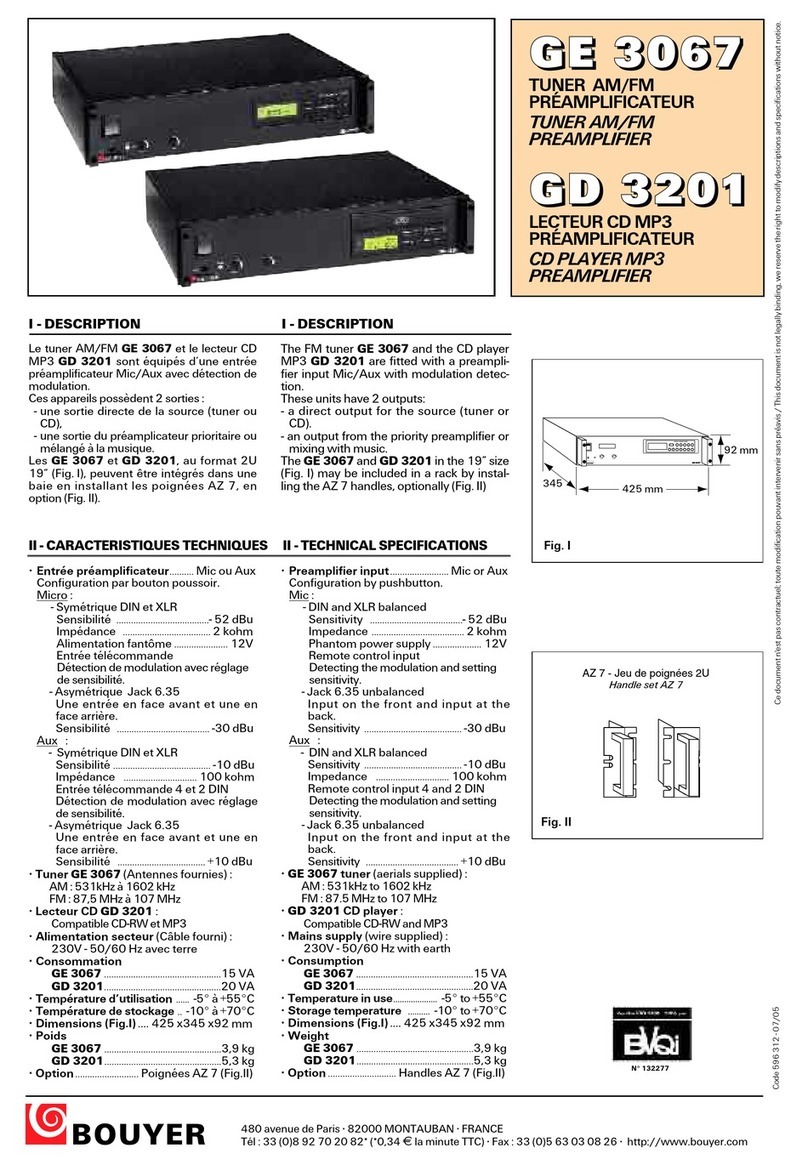
Bouyer
Bouyer GE 3067 User manual

Bouyer
Bouyer AM-2015-PACK User manual
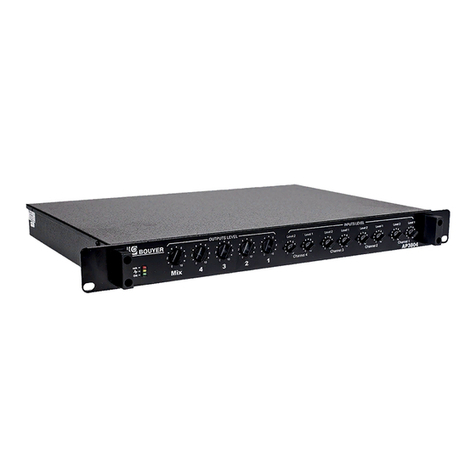
Bouyer
Bouyer AP 3804 User manual
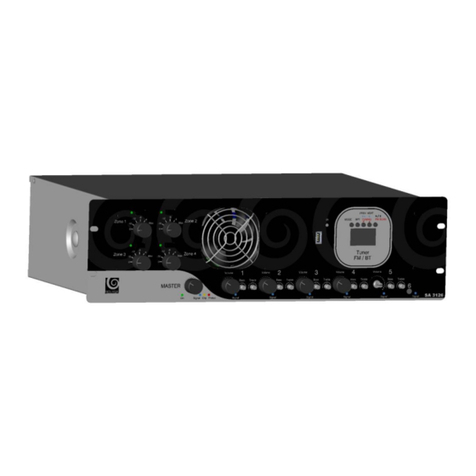
Bouyer
Bouyer SA-3126 Series User manual
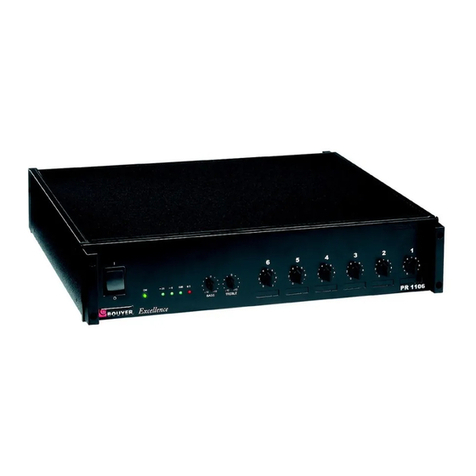
Bouyer
Bouyer EXCELLENCE Series User manual

Bouyer
Bouyer SA 3126 User manual

Bouyer
Bouyer IL 100 User manual
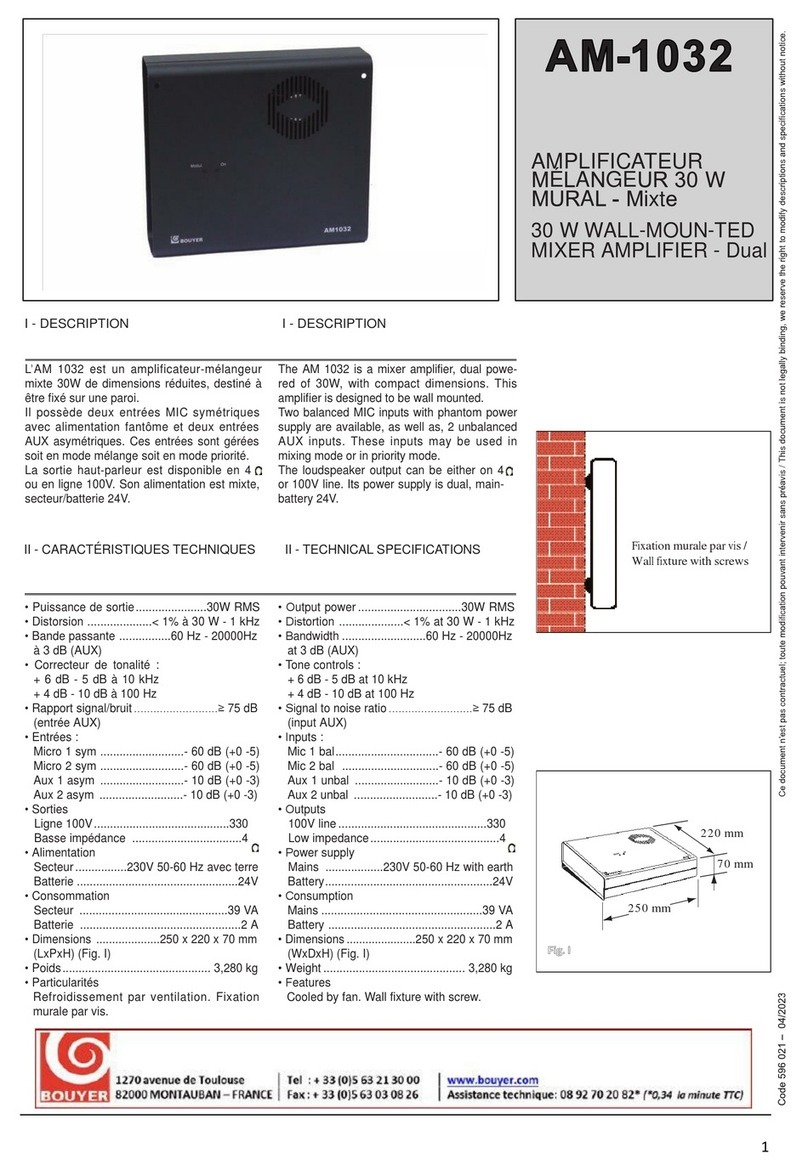
Bouyer
Bouyer AM-1032 User manual
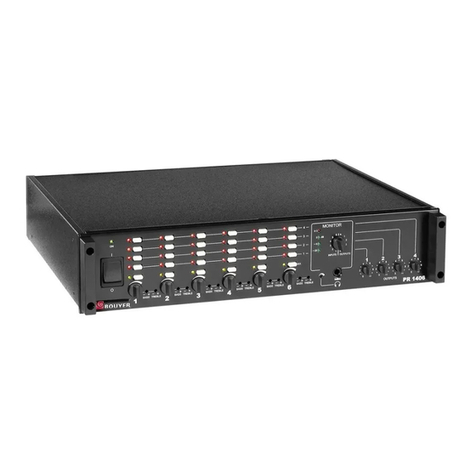
Bouyer
Bouyer EXCELLENCE PR 1406 User manual
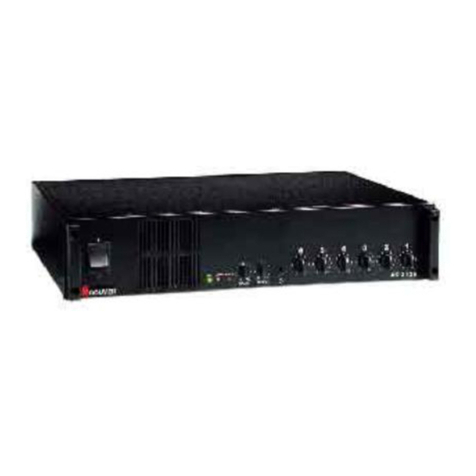
Bouyer
Bouyer AS 3066 User manual
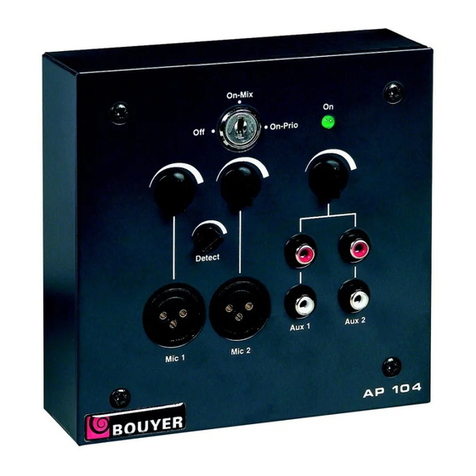
Bouyer
Bouyer AP-104 User manual
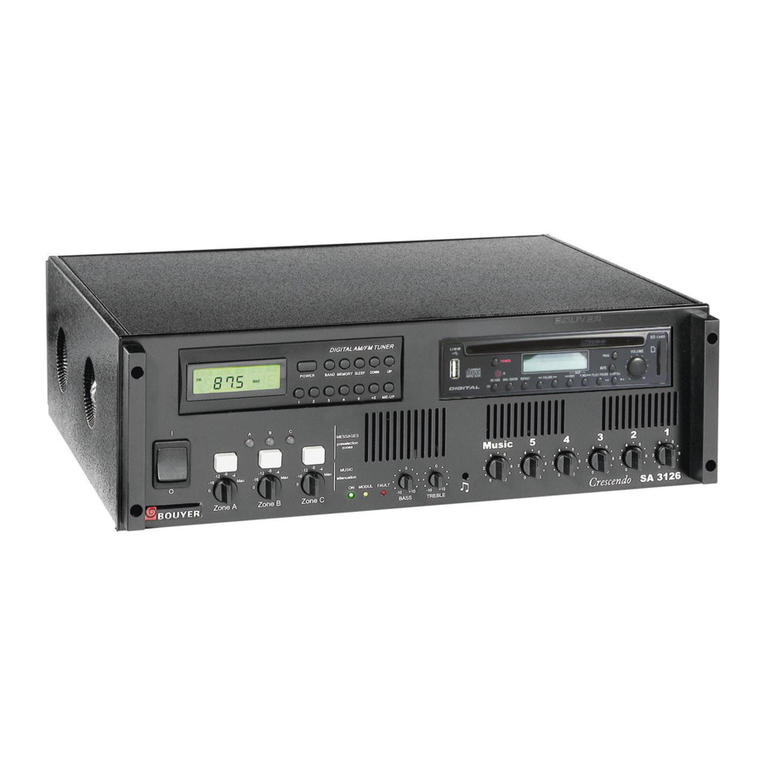
Bouyer
Bouyer Crescendo SA 3126 Instruction manual
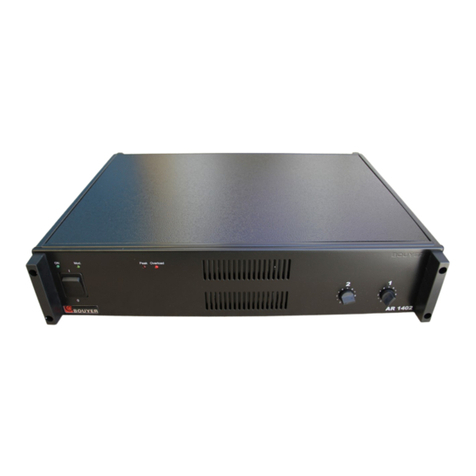
Bouyer
Bouyer AR 1402 User manual
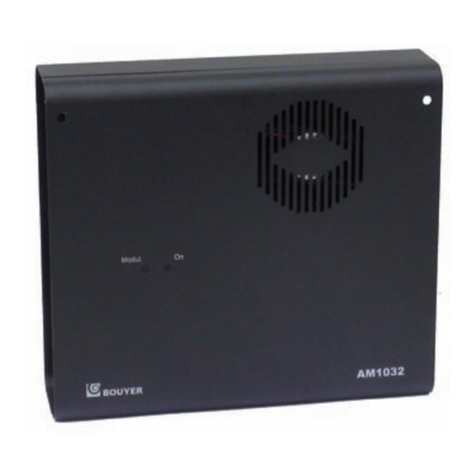
Bouyer
Bouyer AM 1032 I User manual
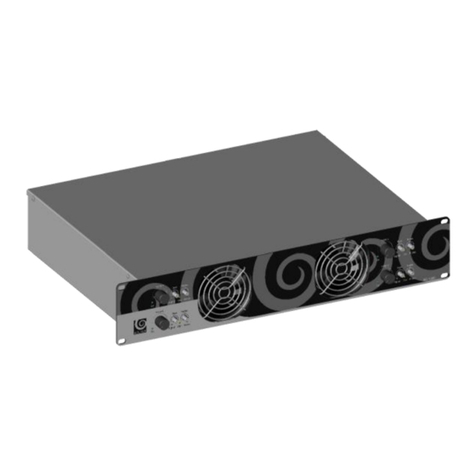
Bouyer
Bouyer AD1-1075 User manual

Bouyer
Bouyer SA-1127 User manual
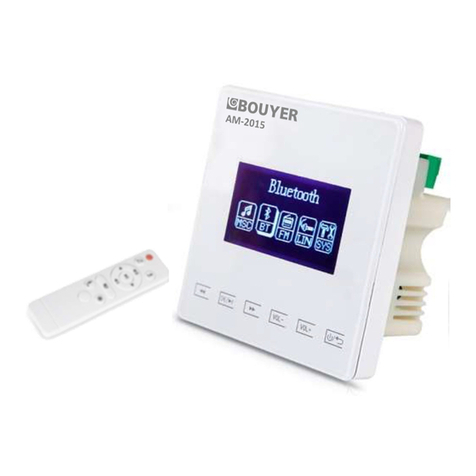
Bouyer
Bouyer AM-2015 User manual

Bouyer
Bouyer AS-4000 Series User manual
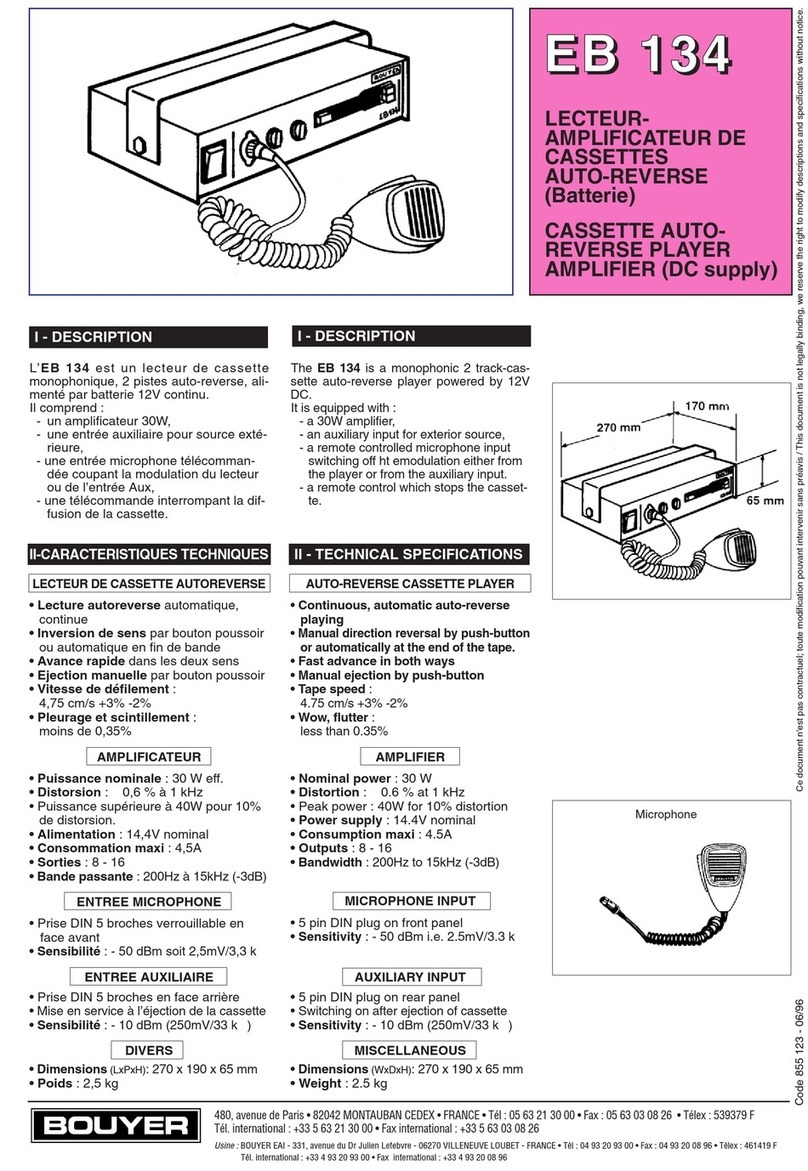
Bouyer
Bouyer EB 134 User manual
